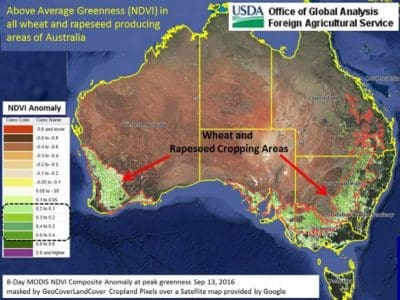THE United States Department of Agriculture (USDA) crop report for October estimates 2016/17 Australia wheat production at 28.3 million metric tons, up slightly from last month and up 16 per cent from 2015/16.
Coinciding with the rise, the area harvested is estimated at 12.9 million hectares, up 0.1 million hectares from last month and up slightly from 2015/16.
The USDA estimates wheat yield at a record 2.19t/ha, up 2pc from last month and up 15pc from 2015/16.
Rapeseed (canola) production is estimated at 3.7mmt, up 24pc from last year. The area harvested is estimated at 2.5 million hectares, up 6pc from 2015/16.
Yield is estimated at 1.48t/ha, up 10pc from last month and up 17pc from 2015/16, and the highest in the past 10 years.
The report says there have been good growing conditions for both crops during early September with precipitation above average since sowing operations commenced in May. Soil moisture in virtually all rapeseed and wheat cropping areas has markedly improved from the relatively dry conditions which prevailed during much of the previous year.
Field conditions are considered near ideal in most regions with the exception of localised losses resulting from flooding in southeast Australia and frosts in Western Australia.
Seasonal analysis of satellite imagery reveals above-average Moderate Resolution Imaging Spectroradiometer (MODIS) NDVI (normalized difference vegetation index) indicating healthy vegetative conditions since May for all major wheat and rapeseed producing states.
The report also forecasts the 2016/17 Australian cotton crop will produce 4.0 million bales, up 0.5 million or 14pc from last month, and up 1.4 million or 54pc from last year.
The harvested cotton area is forecast at 475,000ha, up 65,000ha or 16pc from last month, and up 163,000ha or 52pc from last year.
Yield is forecast at 1833 kilograms/ha. Yield is expected to decrease because of a forecast increase in the share of the total area sown to dryland cotton.
Irrigated cotton yields are substantially higher than dryland yields and the difference widens in low rainfall years.
On average about 90pc of Australia’s total cotton production comes from irrigated areas.
This will be the first time in three years that a significant area has been planted to dryland cotton.
Dryland planting tends to vary with seasonal weather forecast and prices at sowing.
This season’s above-average rainfall has increased water storage for irrigated cotton and provided adequate soil moisture in dryland cotton areas.
Irrigated cotton area is forecast to increase, reflecting increased water storage levels in reservoirs supplying cotton growing regions.
Also, higher cotton prices relative to sorghum will shift sorghum area to cotton in Queensland and northern NSW where these crops compete.
Source: USDA



HAVE YOUR SAY